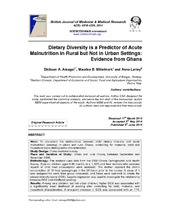| dc.contributor.author | Amugsi, Dickson Abanimi | |
| dc.contributor.author | Mittelmark, Maurice B. | |
| dc.contributor.author | Lartey, Anna | |
| dc.date.accessioned | 2015-07-06T08:41:37Z | |
| dc.date.available | 2015-07-06T08:41:37Z | |
| dc.date.issued | 2014-06-05 | |
| dc.identifier.issn | 2231-0614 | |
| dc.identifier.uri | https://hdl.handle.net/1956/10128 | |
| dc.description.abstract | Aims: To document the relationships between child dietary diversity and acute malnutrition (wasting) in urban and rural Ghana, controlling for maternal, child and household socio-demographic characteristics. Study Design: Cross sectional survey Place and Duration of Study: Urban and rural Ghana, between September and November 2008. Methodology: The analysis uses data from the 2008 Ghana Demographic and Health Survey. Data on children aged 6-36 months (n = 1,187) and their mothers who provided reports of child food consumption were analysed. The mother reported the child’s consumption of 16 food types/groups in the 24 hours prior to the survey. A value of 1 was assigned for each food group consumed, and these were summed to create the dietary diversity score (DDS). Logistic regression was used to investigate the relationship between DDS and childhood wasting. Results: Among rural children, but not urban children, higher DDS was associated with a significantly lower likelihood of wasting after controlling for child, maternal, and household characteristics. A one-point increase in DDS was associated with an 11% reduced odds of being wasted (OR = 0.89, 95%, C.I. 0.80 - 0.99). There was also an interaction effect with a higher likelihood of wasting predicted by lower DDS when maternal BMI was low. Conclusion: Dietary diversity has a modest but statistically significant association with acute malnutrition in rural but not in urban Ghana. Interventions to combat acute malnutrition in rural settings should include efforts to promote the consumption of a variety of food groups. | en_US |
| dc.language.iso | eng | eng |
| dc.publisher | Sciencedomain international | eng |
| dc.relation.ispartof | <a href="http://hdl.handle.net/1956/10126" target="blank">Child Care Practices, Resources for Care, and Nutritional Outcomes in Ghana: Findings from Demographic and Health Surveys</a> | eng |
| dc.rights | Creative Commons Attribution License (CC BY) | eng |
| dc.rights.uri | http://creativecommons.org/licenses/by/3.0/ | eng |
| dc.subject | dietary diversity | eng |
| dc.subject | nutritional status | eng |
| dc.subject | wasting | eng |
| dc.subject | urban-rural | eng |
| dc.subject | Ghana | eng |
| dc.title | Dietary Diversity is a Predictor of Acute Malnutrition in Rural but Not in Urban Settings: Evidence from Ghana | eng |
| dc.type | Peer reviewed | |
| dc.type | Journal article | |
| dc.description.version | publishedVersion | |
| dc.rights.holder | Copyright the authors. | eng |
| dc.source.journal | British Journal of Medicine & Medical Research | |
| dc.source.40 | 4 | |
| dc.source.14 | 25 | |
| dc.source.pagenumber | 4310-4324 | |
| dc.subject.nsi | VDP::Medisinske Fag: 700::Helsefag: 800 | |

